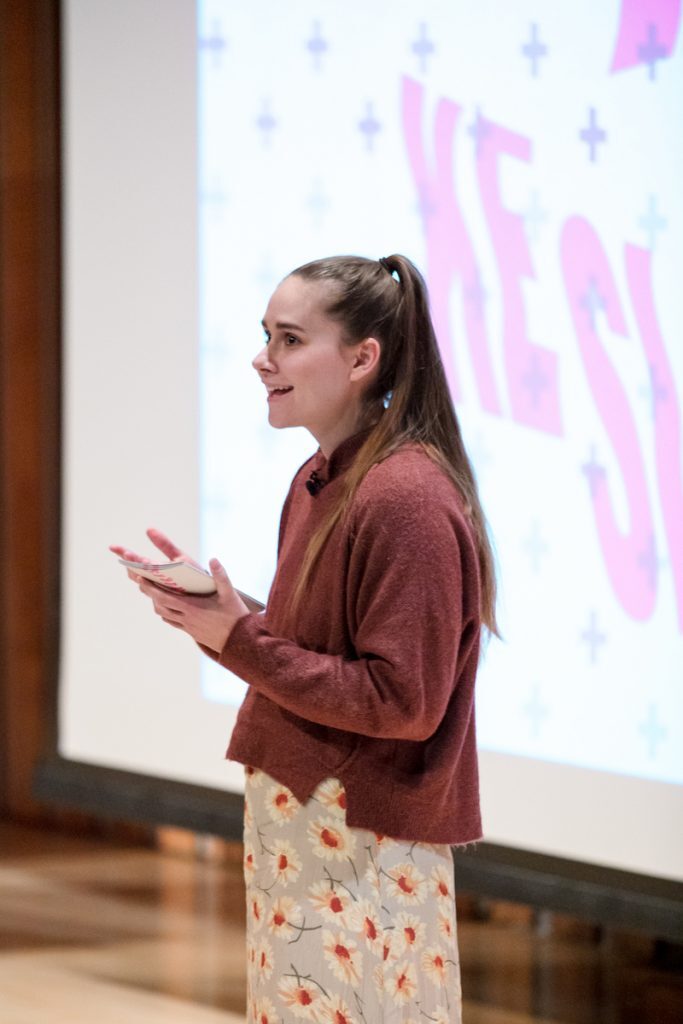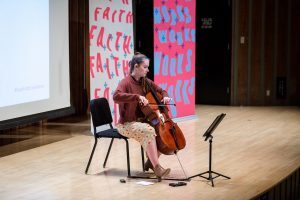School of Music Professor Michelle Kesler explores if one can find meaning independent of the outcome throughout the creative process.

For most creative fields, the outcome is the main goal — but the reality is that end product does not materialize simply from nothing. In her Feb. 1 Faith + Works Lecture, School of Music Professor Michelle Kesler explores if one can find meaning independent of the outcome throughout the creative process. During her lecture, Kesler shared experiences from her life that have caused her to reflect on this dilemma. When she was four years old she started playing the cello, and from there her love for music only grew. “I immersed myself in every way possible that I could play music,” said Kesler. “I loved every aspect.” In grad school, Kesler realized she needed to become more competitive if she wanted to make it as a musician, so she started practicing six to eight hours a day. The increased time she spent practicing caused her to question the real value of the creative process. As she would sit for hours on end in a windowless 5x5 practice room, a quote from one of her ASU professors would run through her mind: “We must always be discovering new depth and levels of meaning to what we do. We have a great responsibility as musicians to create beauty, let it affect us, and then reveal it to others….Being a musician is much more than an occupation. We must constantly be raising the bar higher and higher for our own musical growth and discover how we can use our talents and passions to better our society.” The isolating effect of practicing by herself for hours on end also caused Kesler to question how her practice fit into this larger picture and what its inherent value was. “I started to think about how my faith related to these long hours of practice. I never questioned the importance or value of the performance and how much that can communicate to an audience, how meaningful and profound that is,” said Kesler. “For me, I wanted the practice hours to be an end in itself.” For Kesler, the turning point to finding meaning in the creative process was viewing it as a sacred process. “Relying on my faith in practice meant that I was recognizing all other ways I was growing. It wasn’t just the technical mastery; it was spiritually, physically and mentally strengthening me as a person and not just one part of me, a musician,” said Kesler. “When I started to think of it as a sacred process, I started to consider that there were these attributes I was developing that were also attributes our Savior possesses.” Kesler found that these attributes included the ability to listen, humility, learning, patience, empathy and creativity — all traits that are vital in other aspects of life. “Why shouldn’t the time we spend in the practice room benefit other facets of our lives and all our relationships?” said Kesler. Kesler has investigated this question in her own life, especially through her work as a National Parks Artist-In-Residence at Hubbell Trading Post and Canyon de Chelly in Arizona.

During her lecture, Kesler played a new music piece called “Quiver,” which she worked on with Navajo composer Raven Chacon during her residency. Kesler shared the piece as an example of a piece that “celebrates the process.” “Each gesture is it’s own process. When I perform it, it feels less like an end goal and more like an experience that is continually evolving in meaning and in sound,” said Kesler. “When I play it I feel patience, humility, and empathy.” Kesler said that anyone can apply the art of celebrating the process to their own lives. “There are so many more hours of practice than actual performance, so don’t let the process be an unmeaningful thing. Really connect spiritually with it,” said Kesler. “It’s made me feel more fulfilled as a musician when I view the process as sacred.